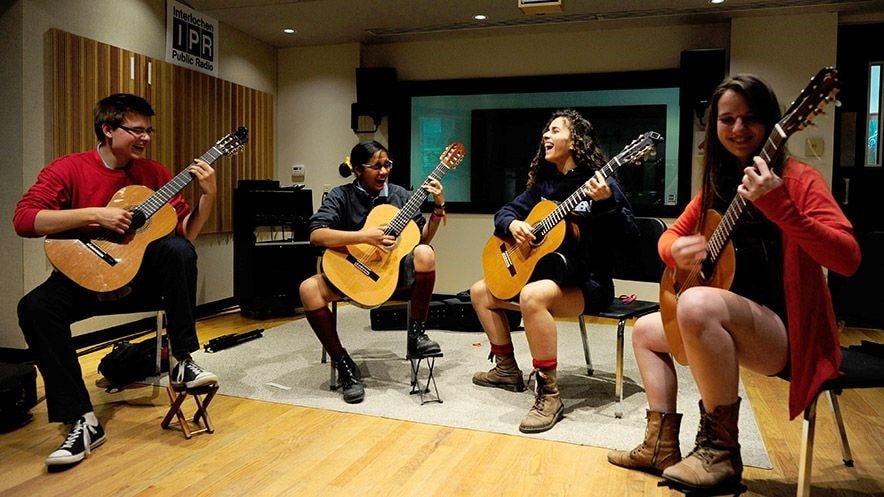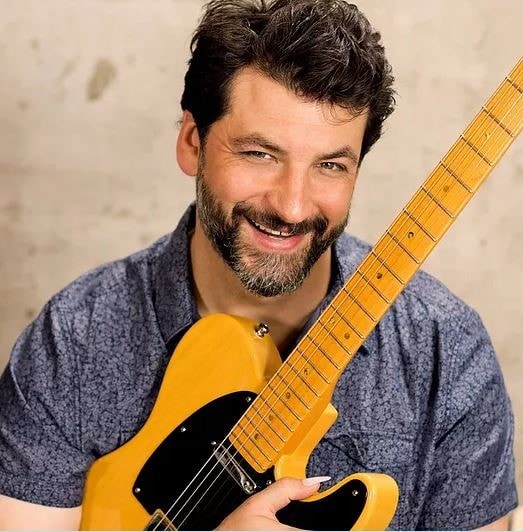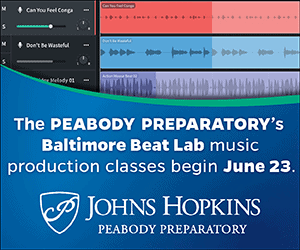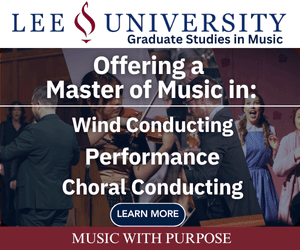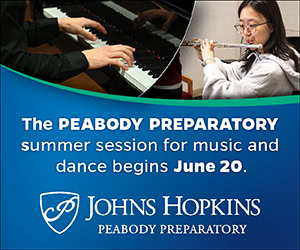/ News Posts / Guitar Class in the Great Lakes State
Guitar Class in the Great Lakes State
Number 20: The State of Michigan
By Thomas Amoriello Jr.
NAfME Council for Guitar Education
In this latest edition of “50 States of Guitar Class,” the NAfME Council for Guitar Education visits with Dr. Matthew Cochran who is the Guitar Instructor at Interlochen Center for the Arts, where he teaches talented high school students at the Interlochen Arts Academy. Interlochen Arts Academy is recognized as one of the finest pre-professional schools for young musicians around the world. Music students benefit from personal attention, classes in music theory, numerous performance opportunities with large and small ensembles and an exceptional peer group. A combination of private lessons, studio classes, and ensemble experiences prepares students for a future study in music.
Cochran is director of both Classical Guitar and Singer-Songwriter programs at Interlochen Arts Camp. He is an in-demand guest lecturer, ensemble coach, and conductor, and has taught masterclasses at guitar festivals, performing arts high schools, and colleges throughout the Unite States, Canada, and Europe. During the summer months Cochran teaches at Interlochen’s three-week Classical Guitar Camp and also teaches “Contemporary Guitar” which is the umbrella term for styles of guitar playing that don’t necessarily consist of composed music. He also coaches House Band, Interlochen Arts Academy’s Contemporary Music large ensemble.
“From time to time I teach masterclasses, give lectures about music education, or judge the odd guitar competition outside the borders of Northern Michigan. This is especially enjoyable during winter months, when the weather gets a bit chilly back home.”
Cochran performs early music, new music, popular music, and unpopular music. He holds a Doctorate in Guitar Performance from Florida State University, and MM and BM degrees in Guitar Performance from the Eastman School of Music. We thank him for sharing his insights with the NAfME membership.
Please tell us about your school and overall music program.
Interlochen Arts Academy (IAA) is a Fine Arts boarding high school that offers artistic training combined with comprehensive, college-preparatory academics. There are approximately 520 students enrolled in the Academy in a variety of disciplines ranging from music to film to creative writing to dance. There are currently 14 students in the guitar program, which features a mixture of classical, jazz, and popular music idioms.
Please tell us about your own personal musical background growing up and your collegiate experience.
I fell in love with the guitar when I heard Mark Knopfler from the Dire Straits. The “Brothers in Arms” record was released in 1985, and it featured songs like “Walk of Life” and “Money for Nothing.” To my ears, it was the most unique sounding record of the era, and as a 10-year-old, I devoted hours of my life to learning how to sound like Mark Knopfler. I never quite succeeded, but in the process, I became obsessed with the instrument and all its stylistic variety. In my early teens, I began to study classical guitar, mostly because I was told that I needed to do so if I wanted to pursue guitar in college. I don’t remember who told me that, and it was far from a perfect fit for me at first. However, I was eventually won over by the compositions of Villa-Lobos, Britten, and Bach, and particularly by the magical recordings of Julian Bream.
I attended the Eastman School of Music for my Bachelor and Master’s degrees, studying Guitar Performance with the great Nicholas Goluses. I moved to Florida in 2001 to work on my doctorate with Bruce Holzman at Florida State University. I thoroughly enjoyed my musical education; my teachers were generous and patient, and they remain dear friends today.
How do the guitar family of instruments fit into your teaching?
At Interlochen, my teaching days vary greatly, but the guitar figures into almost all of my activities. Half of my students are traditional classical guitarists, and the other half are Contemporary Music majors, which can include anything from “shredders” to jazz to singer-songwriter-composers. My studio is always a jumble of electric guitars and basses, amplifiers, nylon and steel-string guitars, and the occasional banjo or mandolin if students are preparing musical theater works.
What obstacles did you face when you were first hired at your school? Now?
I was hired in 2016 and tasked with growing IAA’s Guitar program in both size and scope. We’re an international boarding school located in the north woods of Michigan, quite far removed from any metropolitan center, and recruiting was a major hurdle at first! There were four guitar majors my first year at the Academy. Thankfully, that number has steadily increased each year.
I have a lot of help: Dr. Kedrik Merwin, Director of Music at Interlochen, is a tireless and visionary leader, and his guidance and support have been invaluable. I’m also lucky to have extraordinary artistic colleagues, and a world-class admissions team who help to spread the word about the guitar program to prospective students.
What kind of classes related to the guitar do you teach?
I teach private guitar lessons, Class Guitar, Music Production and Technology, and I direct two ensembles: the Interlochen Guitar Ensemble, which focuses on traditional and contemporary classical ensemble repertoire, and House Band, Interlochen’s Contemporary Music large ensemble, whose repertoire ranges from Pop/Rock to musical theater to electronic dance music.
Do you have any success stories you would like to share about students (musical and non-musical)?
Interlochen’s guitar alumnus can be found throughout the music industry, with notable touring artists like Gohar Vardanyan and Austin Classical Guitar founder Matthew Hinsley leading the direction of the contemporary classical guitar scene. I came to IAA in 2016 and in that time Interlochen guitar majors have gone on to study at San Francisco Conservatory, Brown University, Berklee College of Music, New England Conservatory, and CalArts.
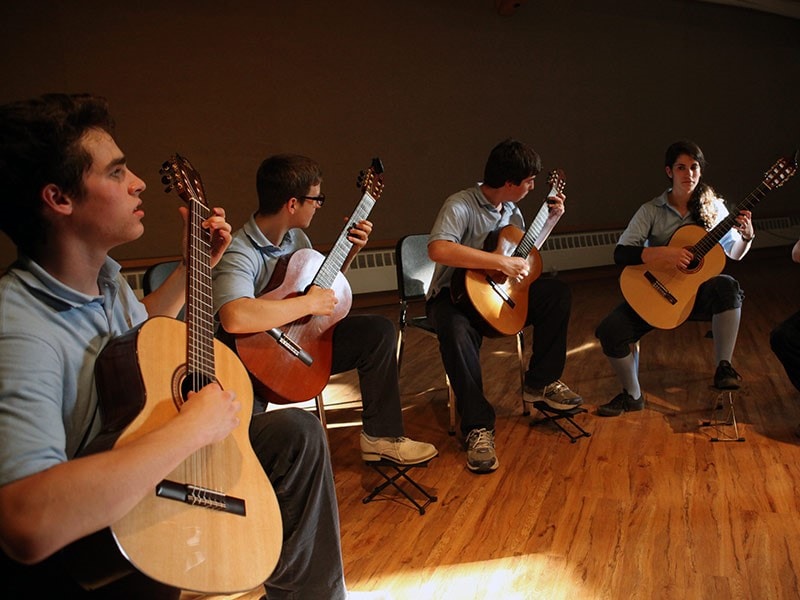
Photo courtesy of Dr. Matthew Cochran
What do you tell your talented students who are planning to pursue music or guitar studies in high school or college after they finish with you?
I am lucky to work with gifted, ambitious young musicians who take their craft very seriously. Most, if not all of my current students plan to pursue music as a profession, and as a group we regularly discuss the joys and challenges of auditioning for college/conservatory, finding work, and developing ways to stand out in a crowded field of professionals.
My own career veered pretty far from the path I set out for myself as an undergraduate guitar performance major in the mid ’90s. As a 20-year-old, I wanted the career Julian Bream had—lots of travel, concertizing, accolades, etc. I didn’t realize that Bream’s career, like Bream himself, was an entirely unique and rare entity. There are, of course, no job postings for a “concert classical guitarist.” So upon graduation from university, I was faced with the realization that my chosen profession isn’t so much a profession as it is a series of choices I would make and skills I would develop.
I taught in high schools and community colleges, performed with a guitar quartet, worked administrative jobs for a performing arts organization, wrote and performed original music (classical and popular), played in a bunch of music theater pits and bands, had a surprise success with a podcast called “Goes2Eleven,” did audio production and sound design for NPR and BBC. I wasn’t always qualified for the work I found myself doing, but I benefited greatly from “on-the-job-training.” I’m often astonished that the skills I picked up while maneuvering an unpredictable field are the exact skills I utilize on a daily basis at Interlochen!
My students are generally erudite and way more savvy than I was at their age. They share their goals and concerns, and when they ask, I try to be as transparent as possible about my own professional experience prior to landing at IAA.
Do you have any networking or advocacy tools that have worked for you promoting your program that would help other educators?
I try to seek out partner organizations and individuals primarily based in northern Michigan. I make an attempt to perform and network throughout the Grand Traverse region on a regular basis, and I’ve found the most rewarding relationships reflect a genuine and mutual enthusiasm for music-making, education, and/or the guitar. The Guitar program at Interlochen has received some extraordinary donations lately, all from donors who have developed a personal stake in the success of the program, and can see a direct and positive impact of their donation on students.
Because our community is largely international, I’ve also found that social media plays a big part in communicating what is happening at Interlochen. I frequently upload materials to YouTube, Facebook, and (to a lesser degree) Instagram, and the feedback from that has been quite positive. National organizations like NAfME and the Guitar Foundation of America can offer wonderful networking opportunities, as well as ideas and best practices to bring back to the classroom.
What type of arrangements and/or transcribing have you done for your school performances?
I’ve been arranging and composing for guitar ensembles for 20 years, and each year it seems I learn something new about making the guitar sound good in an ensemble setting. I played in a professional guitar ensemble called Tantalus Quartet for about a decade. I did a number of arrangements for that group, and we were lucky to work with world-class composer/arrangers like Roland Dyens, Gerald Garcia, and Bill Kanengiser, who had some pragmatic advice for guitar ensemble writing and performing. Interlochen recently hosted Chris “Critter” Eldridge (from the Punch Brothers) and jazz virtuoso Julian Lage, who shared some invaluable tips about arranging for the guitar idiomatically. The Interlochen Guitar Ensemble plays a handful of my arrangements or compositions every semester. They’re currently working on my arrangement of Khachaturian’s “Sabre Dance,” and we did a collaboration with Interlochen Public Radio over the holidays celebrating the 200th anniversary of “Silent Night.”
Do you participate in any musical performances or activities outside of your teaching duties?
Absolutely! I’ve been playing an increasing number of solo guitar concerts lately. My current program includes works by Bach, Walton, Turina, and Minnesota-based composer Edie Hill. Last summer I gave my first performance of Rodrigo’s “Concierto de Aranjuez” with an orchestra, which was a thrill! I’m preparing a recording of Bach’s complete solo violin works (BWV 1001-BWV 1006) transcribed for guitar. That project doesn’t have a fixed deadline yet, and I’m approaching it as a long-term undertaking.
The musical environment in and around Interlochen is thriving and well-established. I have wonderful, inspiring colleagues who I love to collaborate with whenever the opportunity arises. Some recent favorites include a couple performances of Jeffrey Van’s “A Procession Winding around Me” conducted by John Bragle, and a Spanish song set with Soprano Laura Osgood Brown. The Interlochen Public Radio station is a few hundred yards from my house, and I’ve had a great time as a guest on original programming like “In Studio A” and “Kids Commute.”
Past “Guitar Class in 50 States” articles:
- Number 50: The Granite State (New Hampshire)
- Number 49: The Green Mountain State (Vermont)
- Number 48: The Mountain State (West Virginia)
- Number 47: The Hoosier State (Indiana)
- Number 46: The Mount Rushmore State (South Dakota)
- Number 45: The Pine Tree State (Maine)
- Number 44: The Badger State (Wisconsin)
- Number 43: The Constitution State (Connecticut)
- Number 42: The Evergreen State (Washington)
- Number 41: The Pelican State (Louisiana)
- Number 40: The Beaver State (Oregon)
- Number 39: The Equality State (Wyoming)
- Number 38: The Empire State (New York)
- Number 37: The Old Line State (Maryland)
- Number 36: The Centennial State (Colorado)
- Number 35: The Bay State (Massachusetts)
- Number 34: The Sooner State (Oklahoma)
- Number 33: The Prairie State (Illinois)
- Number 32: The Hawkeye State (Iowa)
- Number 31: The Volunteer State (Tennessee)
- Number 30: The Palmetto State (South Carolina)
- Number 29: The Natural State (Arkansas)
- Number 28: The Tar Heel State (North Carolina)
- Number 27: The Magnolia State (Mississippi)
- Number 26: The Peace Garden State (North Dakota)
- Number 25: The Treasure State (Montana)
- Number 24: The First State (Delaware)
- Number 23: The Buckeye State (Ohio)
- Number 22: The Yellowhammer State (Alabama)
- Number 21: The Sunflower State (Kansas)
- Number 19: The Lone Star State (Texas)
- Number 18: The Bluegrass State (Kentucky)
- Number 17: The Golden State (California)
- Number 16: The Show-Me State (Missouri)
- Number 15: The Keystone State (Pennsylvania)
- Number 14: The Last Frontier State (Alaska)
- Number 13: The Beehive State (Utah)
- Number 12: The Peach State (Georgia)
- Number 11: The Cornhusker State (Nebraska)
- Number 10: The Gem State (Idaho)
- Number 9: The Old Dominion (Virginia)
- Number 8: The Aloha State (Hawaii)
- Number 7: The Land of Enchantment (New Mexico)
- Number 6: The Sunshine State (Florida)
- Number 5: The Grand Canyon State (Arizona)
- Number 4: The Ocean State (Rhode Island)
- Number 3: The North Star State (Minnesota)
- Number 2: The Silver State (Nevada)
- Number 1: The Garden State (New Jersey)
About the author:
 Thomas Amoriello Jr. serves as the chair on the NAfME Council for Guitar Education and is also the Chairperson for the New Jersey Music Education Association. Tom has taught guitar classes for the Flemington Raritan School District in Flemington, New Jersey, since 2005 and was also an adjunct guitar instructor at Cumberland County College, New Jersey, for five years. He has earned a Master of Music Degree in Classical Guitar Performance from Shenandoah Conservatory and a Bachelor of Arts in Music from Rowan University. He is the author of the children’s picture books A Journey to Guitarland with Maestro Armadillo and Ukulele Sam Strums in the Sand, both available from Black Rose Writing. He recently made a heavy metal recording with a stellar roster of musicians including former members of Black Sabbath, Whitesnake, Ozzy Osbourne, Yngwie J. Malmsteen’s Rising Force, and Dio that was released on H42 Records of Hamburg, Germany. The record released on 12-inch vinyl and digital platforms has received favorable reviews in many European rock magazines and appeared on the 2018 Top 15 Metal Albums list by Los Angeles KNAC Radio (Contributor Dr. Metal). Visit thomasamoriello.com for more information.
Thomas Amoriello Jr. serves as the chair on the NAfME Council for Guitar Education and is also the Chairperson for the New Jersey Music Education Association. Tom has taught guitar classes for the Flemington Raritan School District in Flemington, New Jersey, since 2005 and was also an adjunct guitar instructor at Cumberland County College, New Jersey, for five years. He has earned a Master of Music Degree in Classical Guitar Performance from Shenandoah Conservatory and a Bachelor of Arts in Music from Rowan University. He is the author of the children’s picture books A Journey to Guitarland with Maestro Armadillo and Ukulele Sam Strums in the Sand, both available from Black Rose Writing. He recently made a heavy metal recording with a stellar roster of musicians including former members of Black Sabbath, Whitesnake, Ozzy Osbourne, Yngwie J. Malmsteen’s Rising Force, and Dio that was released on H42 Records of Hamburg, Germany. The record released on 12-inch vinyl and digital platforms has received favorable reviews in many European rock magazines and appeared on the 2018 Top 15 Metal Albums list by Los Angeles KNAC Radio (Contributor Dr. Metal). Visit thomasamoriello.com for more information.
Interested in reprinting this article? Please review the reprint guidelines.
The National Association for Music Education (NAfME) provides a number of forums for the sharing of information and opinion, including blogs and postings on our website, articles and columns in our magazines and journals, and postings to our Amplify member portal. Unless specifically noted, the views expressed in these media do not necessarily represent the policy or views of the Association, its officers, or its employees.
Catherina Hurlburt, Marketing Communications Manager. June 27, 2019. © National Association for Music Education (NAfME.org)
Published Date
June 27, 2019
Category
- Ensembles
Copyright
June 27, 2019. © National Association for Music Education (NAfME.org)
